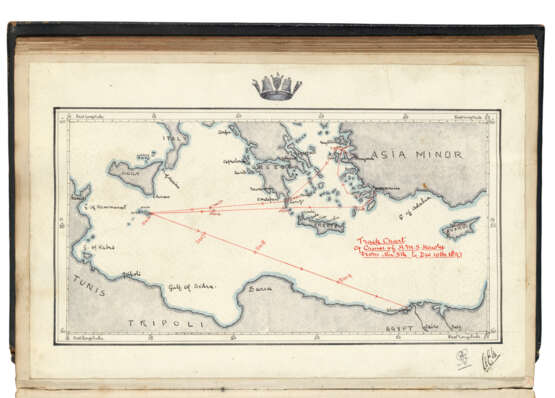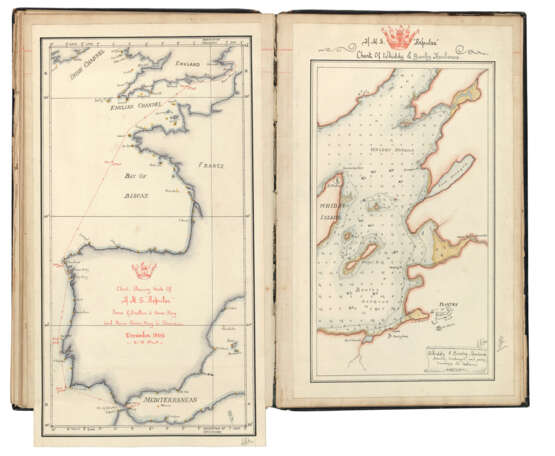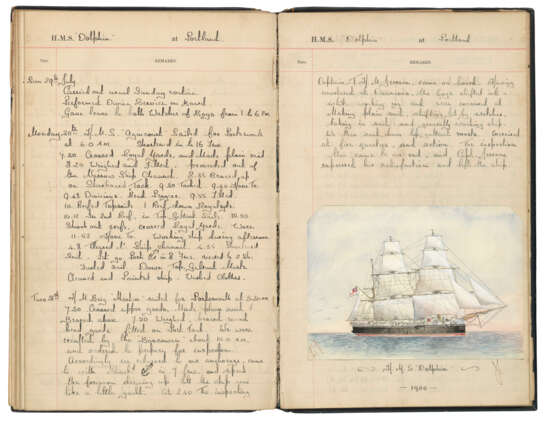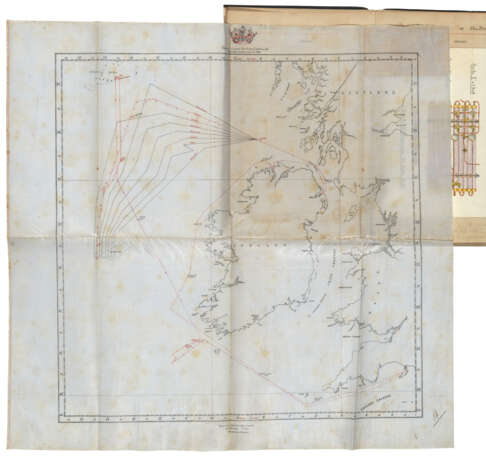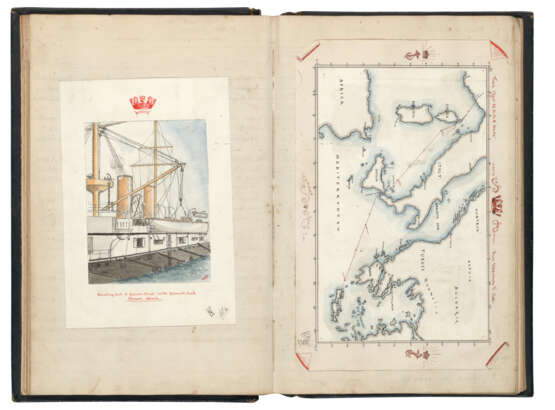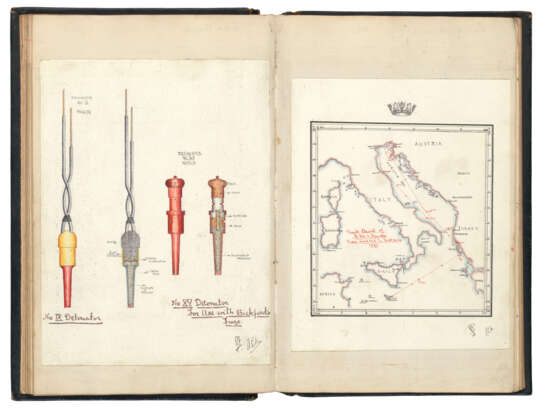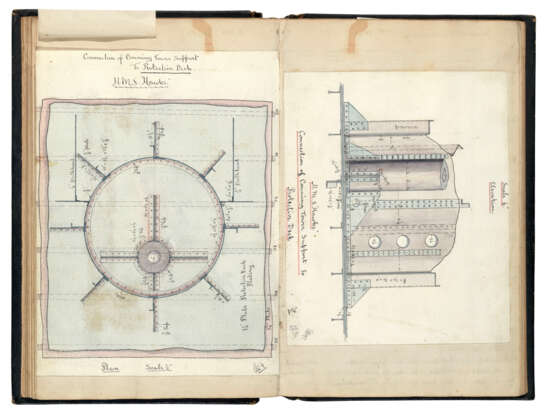ID 794399
Los 64 | EVANS, Edward, 1st Baron Mountevans (1880-1957)
Schätzwert
£ 8 000 – 12 000
Autograph manuscript midshipman’s log books, 1897-1900.
Autograph manuscript midshipman’s log books for HMS Hawke, HMS Repulse, HMS Dolphin and HMS Duke of Wellington, chiefly in the central Mediterranean and off the coasts of England and Ireland, 15 January 1897-14 November 1900.
Two volumes, 315 x 205mm each, part-printed log books produced in London for H.M. Stationery Office by Waterlow & Sons Limited, the first volume signed on title page (‘ERG Evans’), the logs comprising daily entries recording the date, location, winds, weather, activities and observations aboard the ships, illustrated with c.40 watercolours, charts and sketches, and one folded chart (c.57 x c.60cm open; showing manoeuvres of the Repulse around Ireland in 1898). Blue morocco, gilt stamped, marbled endpapers (a little worn at spine and edges). Provenance: by descent.
Two exquisitely decorated midshipman’s log books completed by the young Teddy Evans during his first naval postings, extra-illustrated with an extensive series of watercolours and charts. The majority of the first log is given over to proceedings aboard HMS Hawke (January 1897-June 1898), the second volume to HMS Repulse (July 1898-July 1900), with shorter sections at the end of volume II covering events aboard the Dolphin (July 1900-October 1900) and the Duke of Wellington (November 1900). In a neat hand, Evans records the Hawke’s service in the International Squadron during the 1897-1898 Greek uprising on Crete against the Ottomans, as the ship sails between Malta, Chania, Smyrna, and Alexandria; the entries describing the movements of the Repulse on manoeuvres in the English and Irish Channels are longer, but Evans is meticulous in his record-keeping across both volumes. The central appeal of the logs lies in their accomplished illustration, a testament to the curiosity and attention to detail of the young Teddy Evans. Evans renders the ships on which he serves, and others who serve alongside, in delicate watercolour, plots intricate charts for courses sailed, or, elsewhere, might be equally absorbed in a detailed colour diagram showing the composition of 6-inch shells aboard HMS Hawke or a sketch of an anchor or a winch. Some of the watercolours are signed or initialled; in certain of the drawings or entries for HMS Hawke, the ship’s captain, Sir Richard Poore, adds his initials and, occasionally, approving comments on Evans’ progress.
After school career marked by fighting and truancy, the teenage Teddy Evans found the perfect outlet for his boundless physical energy and adventurous disposition in the Royal Navy; in 1897, he was posted to the Mediterranean as a midshipman aboard the cruiser HMS Hawke, before serving aboard the HMS Repulse and the training sloop Dolphin, and in 1900 he was promoted sub-lieutenant. Evans met then-lieutenant Robert Falcon Scott while posted aboard HMS Majestic, and when Scott sailed for the Antarctic the following year, Evans petitioned Sir Clements Markham to be seconded to the SY Morning, due to follow the Discovery as a relief ship. Sailing from London in 1902, the Morning located the Discovery fast in the polar ice; the two crews met in the McMurdo Sound, with Evans among the first party to greet the Discovery's crew, and the Discovery was re-supplied, but remained trapped in the ice. The Morning was obliged to leave her there for a second winter, returning to Christchurch for a re-fit with a number of the Discovery’s crew aboard, including her third officer, Ernest Shackleton. In January 1904 the Morning returned, accompanied by the Terra Nova; the Discovery was broken free from the ice in February, and the three ships returned home. Scott named Cape Evans in recognition of Teddy Evans’ role in the relief mission and, in 1909, selected him as second-in-command of his second Antarctic expedition, which left England in June 1910, with Evans as captain of the Terra Nova. He accompanied Scott in January 1912 to within 150 miles of the pole, where he was forced to turn back, leaving Scott and the rest of the ill-fated Southern party to press on towards the Pole. Struck down by scurvy on the return, he was saved only by the devotion of his two companions, Chief Stoker Lashly and Petty Officer Crean. Following his Antarctic service, Evans had a successful naval career, serving as a commander in the First World War – during which he became a popular hero as ‘Evans of the Broke’ for his counter-attack, aboard a ship of that name, against six German destroyers that had bombarded Dover harbour – and, subsequently, as rear-admiral commanding the Royal Australian Navy, then Commander-in-Chief, Africa, before serving in the Second World War in the Norwegian Campaign, finally retiring in 1941.
Special Notice
No VAT on hammer price or buyer's premium.
| Herkunftsort: | Nordeuropa, Europa, Vereinigtes Königreich |
|---|---|
| Kategorie des Auktionshauses: | Briefe, Dokumente und Manuskripte |
| Herkunftsort: | Nordeuropa, Europa, Vereinigtes Königreich |
|---|---|
| Kategorie des Auktionshauses: | Briefe, Dokumente und Manuskripte |
| Adresse der Versteigerung |
CHRISTIE'S 8 King Street, St. James's SW1Y 6QT London Vereinigtes Königreich | |
|---|---|---|
| Vorschau |
| |
| Telefon | +44 (0)20 7839 9060 | |
| Aufgeld | see on Website | |
| Nutzungsbedingungen | Nutzungsbedingungen |

